
Masonic, Occult and Esoteric Online Library
Fictitious and Symbolic Creatures in Art
By John Vinycomb
Other Chimerical Creatures and Heraldic Beasts- The Griffin
The griffin, gryfin, or gryphon, as it is variously termed by old writers, is best known as one of the chimerical monsters of heraldry—the mediæval representative of the ancient symbolic creature of Assyria and the East. It may be classed with the dragon, wyvern, phœnix, sphynx, "gorgons and hydras and chimeras dire," and other imaginary beings, that world of unreality grown up in the mind of man from the earliest times, the influence of whose terrors have exercised no little power in the progress of humanity.
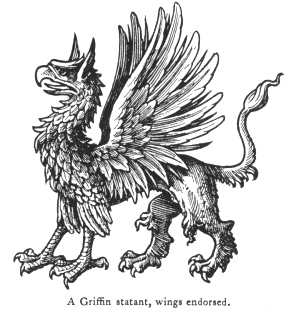
This favourite bearing was very early adopted in English armory. So early indeed as 1167 A.D. we find it on a seal of Richard de Redvers, Earl of Exeter, attached to a charter at Newport, Isle of Wight. It also appears on a seal of Simon de Montacute (temp. Henry III. and Edward I.). It is one of the principal bearings in heraldry, either charged upon the shield, as the arms, or as the crest placed upon the helm, also as supporters to the shield of arms of many noble and eminent families in this country and the continent.
The griffin, "sacred to the sun," combines the bodily attributes of the "cloud-cleaving eagle" and the "king of beasts," that is, it has the head, neck, wings, and talons of an eagle, conjoined to the hinder parts of a lion. It is usually represented with projecting
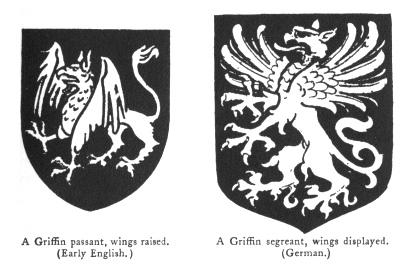
ears, indicating an acute sense of hearing, in addition to its other supposed extraordinary qualities.
The griffin is rarely borne in other than two positions, viz., passant and segreant. The latter term is peculiar to the griffin, and seems to refer to the expanded wings. When called segreant only, it means the same as rampant applied to a lion. As a crest, it is not unfrequently borne sejant, i.e., sitting. Parts of the creature, as a demi-griffin, a griffin's head, &c., are also of common use.
The arms of Trafford, Lancashire, are: Argent a griffin segreant gules. Motto: Gripe griffin hold fast. The supporters of the arms of Viscount Halifax are two griffins.
Old heralds gravely relate of this creature that when he attains his full growth he will never be
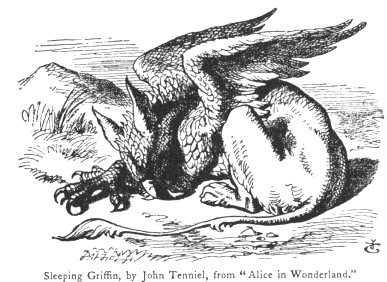
taken, hence he is a fit emblem of a valiant hero, who, rather than yield himself to his enemy, exposes himself to the worst of dangers. As a general symbol in heraldry the griffin expresses strength and vigilance.
Sir Thomas Browne says it is emblematical of watchfulness, courage, perseverance and rapidity of execution.
The description of the griffin by the old traveller, Sir John Mandeville, is a wonderful record of credulity and belief in the marvellous; he states it to be a native of "Bacharie, where ben many griffones, more plentee than in any other countree. Sum men seyn that they have the body upwards of an egle and benethe as a lyonn, and truly they seyne soethe that thei ben of that schapp. But one griffoun hath the body more great and stronger than one hundred egles, such as we have amonges us. For one griffoun there will be flynge to his nest a great hors, or two oxen yoked togidre, as thei gon to the plowghe. For he hath his talouns so longe and so grete and large upon his feet as though thei were hornes of grete oxen, or of bugles (bulls), or of kygn, so that men maken cuppes of hem to drynke of, and of hire (their) ribbes and of the pennes of hire wenges men maken bowes fulle stronge to schote with arrews and quarell." Gerard Leigh, an old heraldic writer, discoursing of the griffin, gives his reason for belief, he says, "I thinke they are of a great hugeness, for I have a clawe of one of their pawes, whiche should shewe them to be as bigge as two lyons."
In the cathedral of Brunswick there is still preserved the horn of some kind of antelope, brought from the Holy Land as "a griffin's claw," by Henry the Lion. Three talons of the griffin were preserved at Bayeux, and fastened on high festival days to the altar, and there seems to be some curious legend concerning a cup formed of a gryphon's claw dedicated to St. Cuthbert. A gryphon's egg was also considered a valuable curiosity, being used as a goblet in old times when natural history was greatly misunderstood and grossly exaggerated. As an example of the absurd misstatements of the earlier writers and naturalists who so delighted our wonder-loving forefathers, a writer in the "Museum of Animated
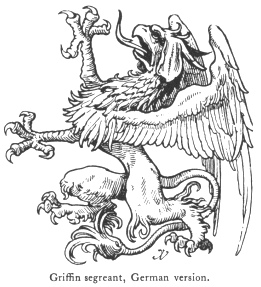
[paragraph continues]Nature" refers to a large species of vulture, the Condor (Sarcoramphus Gryphus), which was painted as rivalling the Rukh of Oriental fable. He adds that "such descriptions have given place to the moderate details of sober-minded observers, and we no longer look upon this creature as the winged guardian of mountain mines within whose depths were entombed 'gems and barbaric gold,' we no longer imagine it the giant of the winged race, dimming the light of the sun by its widespread pinions, and by the mighty rushing sound as it sweeps down from some lofty pinnacle or the upper regions of the sky deafening and stupefying the terror-stricken beholders."
As the stern avenger of human crimes, the dreaded Nemesis appears in Roman Art, as a young woman with wings, in a chariot drawn by griffins, with a whip or sword in her hand. *
Smith's "Classical Dictionary" gives the following: "Gryps or gryphus, a fabulous monster dwelling in the Rhiphæan mountains between the Hyperboreans and the one-eyed Arimaspians, and guarding the treasures of the north. The Arimaspians mounted on horseback attempted to steal the gold, and hence arose the hostility between the horse and the griffin. The body of the griffin was that of a lion, while the head, fore-feet and wings were those of an eagle. It is probable that the origin of the belief in griffins must be looked for in the East, where it seems they have been very ancient. They are also mentioned among the fabulous beasts which guarded the gold of India."
The Arimaspians were a one-eyed people of Scythia who adorned their hair with gold. They were constantly at war with the Gryphons who guarded the gold mines.
"As when a gryphon, through the wilderness . . .
Pursues the Arimaspian, who by stealth
Had from his wakeful custody purloined
The guarded gold."
Paradise Lost, ii.
That the form of the griffin must have been a well understood symbol is evident from the frequency with which it is met in ancient art. Dr. Schliemann, in his explorations of the ancient city of Mycenæ,
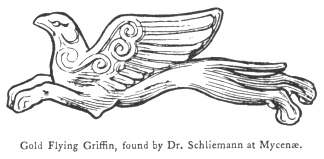
among other treasures found a gold-winged griffin, about two inches in length, in one of the sepulchres of the kings (Figure No. 272 in his book), which in every particular as to shape is identical with the heraldic griffin of to-day; the same may be said of a coin of Abdera, a city in Thrace, which bears the device of a griffin. Abdera was a place of importance when Xerxes invaded Greece B.C. 554.
Herodotus relates that the Teians, dreading the encroachments of the Persians in Ionia, abandoned their city and founded Abdera in Thrace. The coinage of the latter place bears the same type (the griffin)as the parent city, but with a slight difference in treatment. This consists in the form of the wings of the griffin, which are pointed on the coins of Abdera, while in those of Teos they are rounded. The griffin was sacred to Apollo, to whom an especial worship was
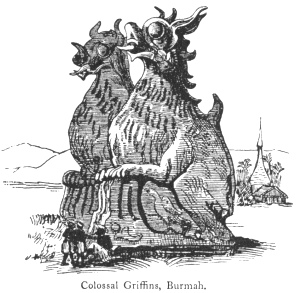
devoted in most of the Ionian cities, but more particularly in Teos. *
In the Illustrated London News of October 21, 1876, is an engraving of two gigantic wingless griffons, and also a description by the traveller who visited that strange place. "At Thyetmo, 250 miles up the river Irrawaddy from Rangoon in British Burmah, are two colossal 'chin thay' or figures of sacred griffins, standing at the entrance to one of the great pagodas dedicated to the worship of Gautama Buddha; the outer terraces and steps of these temples are frequently adorned with such mythical monsters. Near the ancient ruined city of Paghan, which flourished a thousand years ago, the bank of the river for a length of eight miles is lined with the remains of this quaint architecture and sculpture, covering a space of two miles in breadth from the water's edge. It is not known by what nation of old times they were constructed, for Burmese history is apocryphal or at least very obscure."
The symbolic use of images of living creatures was in the instance of the cherubim permitted under the Mosaic dispensation, and on this will be found to turn the distinction between the symbolic use and its forbidden and dangerous use as a supposed means of assisting devotion. Mr. Henry Hayman in Smith's Dictionary," s.v., "cherub," as quoted by Tyrwhit, says: On the whole it seems likely that the word 'cherub' meant not only the composite creature-form of which the man, lion, ox, and eagle were the elements, but further, some peculiar and mystical form which Ezekiel, being a priest, would know and recognise as 'the face of a cherub,' κατ? εξοχ?ν, but which was kept secret from all others. . . . Such were probably those on the ark, which when moved was always covered, though those on the hangings and panels might be of the popular device. The griffin of northern fable, watching the gold in the wilderness, has been compared with the cherub both as regards his composite form and his functions as guardian of a treasure. He goes on to point out the possible affinity between the Greek root γρυπ, (γρυψ, gryps, griffin), and the Hebrew and Arabic derivation of the word 'cherub,' which gives it the original meaning of 'carved image,' and says that though the exact form is uncertain, it must have borne a general resemblance to the composite religious figures found upon the monuments of Egypt, Assyria, Babylonia and Persia."
Mr. Ruskin, * describing the emblematical griffins on the front of the Duomo of Verona, points out that the Lombard carver was enabled to form so intense a conception, mainly by the fact that his griffin is a great and profoundly felt symbolism. Two wheels are under its eagle's wings, which connect it with the living creatures of the vision of Ezekiel, "where they went the wheels went by them, and whithersoever the spirit was to go, they went, and the wheels were lifted up over against them, for the spirit of the living creatures was in the wheels." The winged shape thus became at once one of the acknowledged symbols of the divine nature. Elsewhere, we think in the "Stones of Venice," the connection is pointed out between the Assyrian and Gothic personations.
Gian-Paolo Baglione (+ 1520), who usurped the sovereignty of Perugia, bore a silver griffin on a red field with the motto, "Unguibus et rostro atque alis armatus in hostem" ("Armed against the enemy with talons and beak and wings"), which means of defence proved of no avail when he was seized by Pope Leo X., who, pretending to consult Baglione on affairs of importance, sent him a safe conduct to Rome, but when he arrived, he caused him to be tortured and beheaded, and afterwards took possession of his states. This gave occasion to his enemies to say, "This ugly bird has not used his wings as at other times, to flee from the snare which has been laid for him." *
In Dante's description of the triumph of the Church, in the Purgatorio," we have the mediæval conception of this wondrous creature, the gryphon. "The mystic shape that joins two natures in one form"—as he is called by the noble Italian poet—draws the car to which he is harnessed, and
"He above
Stretched either wing uplifted ’tween the midst
. . . . .
And out of sight they rode. The members, far
As he was bird, were golden; white the rest,
With vermeil interveined."
And when the eyes of Beatrice
"stood Still,
fix’d toward the gryphon, motionless.
p. 159
As the sun strikes a mirror, even thus
Within those orbs the twyfold being shone;
For ever varying, in one figure now
Reflected, now in other. Reader! muse
How wondrous in my sight it seem’d, to mark
A thing, albeit steadfast in itself,
Yet in its imaged semblance mutable."
Cary's Dante, Purgatory, c. xxix.
"Some commentators of Dante," says M. Dideron, * "have supposed the griffin to be the emblem of Christ, who, in fact, is one single person with two natures; of Christ in whom God and man are combined. But in this," says M. Dideron, "they are mistaken. There is, in the first place, a manifest impropriety in describing the car as drawn by God as a beast of burden." "Commentators," it is added, "have been misled by the two-fold nature of the gryphon, but that difficulty is removed by recollecting that the Pope resembles the eagle in his spiritual character, and in his temporal authority the lion. The Pope is one person, but of two natures and two distinct forms. Thus considered the allegory of Dante becomes clear and intelligible."
The gryphon is very frequently seen sculptured in Gothic churches, more especially in those of the Lombard and early Norman style, and is evidently intended to refer to the union of the divine and human natures.
A curious example of this compound form of bird and beast occurs on an Italian bronze medal of the fifteenth century, about 3½ in. in diameter (No. 57.51 in the fine collection in South Kensington Museum). On one side it bears a portrait of Niccolo Picininus of
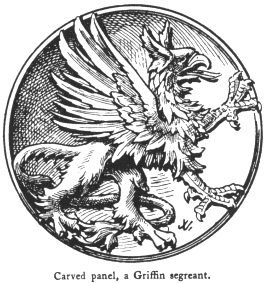
[paragraph continues]Perugia, a celebrated mercenary soldier—and on the reverse a griffin, the eagle's head, wings, and feet united to the Roman she-wolf, with Romulus and Remus suckling. Dante's emblem of the Popedom is here apparently adapted to the peculiarly Roman national symbol—the nursing mother of nations and the Catholic religion.
Footnotes
153:* "Mythology of Greece and Rome, with special reference to its Use in Art," from the German of O. Seemann.
155:* W. N. Humphry's "Coin Collector's Manual."
157:* "Modern Painters," vol. iii. ch. 8.
158:* "Historical Devices, Badges, and War Cries," p. 10.
159:* "Iconography of Christian Art."
